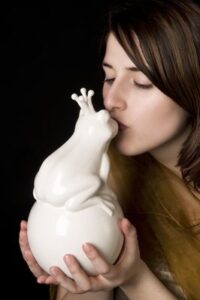 Deep Democracy is a fascinating approach to both personal and organization development. Join me as I join this wonderful workshop to learn more…
Deep Democracy is a fascinating approach to both personal and organization development. Join me as I join this wonderful workshop to learn more…
Kiss a frog? Ugh! It’s natural for most of us to avoid or ignore ugliness, to control problems, wish them away or fight and conquer them. We tend to dislike problems, obstacles, and challenges. Let alone accept, invite and love them. But what if we did…? What if we, leaders, consultants, coaches, professionals, parents, partners – people -, were modern mystics? The way of the mystic is to understand not only through factual information – but through energy and intuition as well. The mystic transforms situations by being part of them – with love. The mystic sees obstacles as opportunities to learn more about himself and the world.
Wait a minute. Is this a blog? It is. If you think you can’t bear mysticism, stop reading. But if you are open to a fruitful approach, join me while I experience this workshop from the Deep Democracy Institute, led by Dr. Max and Dr. Ellen Schupbach.
Deep Democracy and Process Work
Deep Democracy and Process Work is Arnold Mindell’s approach that brings together modern psychology, non-linear dynamics, and quantum physics to discover the wisdom of the “system mind”, the organizing principle of our everyday reality.
Unlike a “classical” democracy, which focuses on majority rule, Deep Democracy suggests that all voices, states of awareness, and frameworks of reality are important. They are all needed to understand the complete process of a system. Deep Democracy is an attitude that focuses on the awareness of voices that are both central and marginal. This type of awareness can be focused on groups, organizations, your inner experiences, people in conflict, etc. If you take seemingly unimportant events and feelings seriously, unexpected solutions to both group and inner conflicts may arise. Deep Democracy is a natural process that occurs in all groups of people but often goes unnoticed or unused.
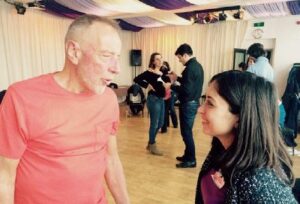
Mindell defines a process as the constant flow of information, manifesting in events that are connected by an underlying organizing principle. Process Work is a widespread approach with applications in collective transformation (change management), individual transformation (psychotherapy), medicine, physics, law, politics, leadership development, and art.
Max and Ellen Schupbach travel the world to teach DD and consult with organizations, and they also organize DD meetings wherever necessary and possible, in Moscow, San Francisco, Cairo, New York, and Ukraine, Palestine, Sierra Leone, Sudan, and Congo to help solve conflicts.
But right now we’re in Amsterdam. Join me while I transform some challenges from frogs into princes (as the fairy tale says). Wouldn’t it be great to transform yours as well? And your organization’s? In these three workshop days, we explore how we normally respond to challenges, and what we can learn from kissing the frog to transform the challenge into an opportunity. Process Work is not always easy to put into words – so bear with me. I’ll do my best to describe what you’d best experience for yourself. Process work is not so much about information (sharing knowledge) as it is about experiencing the energy of what happens. Ready? Let’s dive in.
”The most fundamental forum is your own heart. Both as a facilitator and as a human being, you must learn to hear yourself there.” Arnold Mindell, “Sitting in the Fire”, 1995
I love challenges – not
Hmm, I don’t love challenges. I’m too busy to enjoy them. I want to solve issues quickly. But I am aware of the transformative power of frogs. My partner and I founded a Dutch consultancy firm “Kikker Groep” which is Dutch for Frog Group. The frog symbolizes organizational and personal change. Many people experience change as a frog: something they dread – until they grab it, kiss it and it is transformed into a “prince” or another desired outcome.
Personally, I prefer to transform any frogs as quickly as possible – that suits my pragmatic results-orientation and getting-things-done mentality. But what if I loved the frog? Love is the way of the mystic: it acknowledges that there’s something good about your problem. I would be less hurried if I loved my frog. I’d sit down with that frog, and get to know it better. That is what we will do during this workshop.
Ellen explains an exercise to the participants, who are from all over Europe en even the USA. We’ll choose a disturbance: what bothers you? Next, we’ll kiss that frog, meaning: we’ll make space for the problem. We’ll give it voice, movement, energy – amplify it. When you “get” the energy of this disturbance you may find what’s good in it. When you embrace it, it might shift. This is the magic of the mystic. It’s hard to believe that a frog will become beautiful and be part of the solution – until you experience it.
Ellen and Max give us a demonstration with a participant. Let’s call him Joe. Joe doesn’t go to the doctor while he has a dubious spot on his head that he should have checked. He is an intelligent person running his own business, so why doesn’t he take care of it? He would like to be a pro-active person who takes charge but to be pro-active he would have to let go of his inertia and avoidance.
Having discovered this, Joe is invited to “become the problem” and explore the spirit energy that created the problem. Joe discovers that this energy has to do with his “obstinate self” who likes to loosen up and take things easy instead of the well-dressed and well-behaved self that he identifies with as a responsible adult. His “spot of bother” seems to be a rebel as well as an optimist: “Things will work out, don’t worry, the spot is not malign”.
Next, Joe looks with new wisdom at his old self with the problem. Why has the spot picked Joe?
The answer Joe finds is: to remind him of his lust for life. The message of his frog is: loosen up. What is good about his problem: he discovers how much he loves life! Acknowledging this turns resistance and avoidance into understanding – and a resolve to see a doctor, just to be sure. Do you see what can happen when you play with a frog? Not only the behavior itself changed, but the attitude and mindset that caused the behavior, which results in sustainable behavioral change.
Discover: why did this problem pick you?
 You can do this exercise in pairs, taking turns in facilitating each other. Here’s my example: My frog is that I am too tired, and I hate being tired. The frog must be a visceral fact, not your response to it. So, I work with the bodily feeling of being tired.
You can do this exercise in pairs, taking turns in facilitating each other. Here’s my example: My frog is that I am too tired, and I hate being tired. The frog must be a visceral fact, not your response to it. So, I work with the bodily feeling of being tired.
What new part of myself would I have to welcome to be okay with being tired? I give in to feeling tired to explore its message. I discover the spirit of relaxation and faith. It tells me: “Relax and be present now. Things will move in time. You can’t fast-forward the whole planet by yourself.”
I discover I’m not tired because I work too hard because I have to pay the bills. I work too hard because I’m impatient to see a better world, with more love and kindness at work, at home and in the streets.
What do I have to let go of, to love this tiredness-frog and work with it instead of against it?
I have to let go of my impatience to create a more loving world and of my fear that I can’t pay my bills.
Now, I “kiss the frog”: I become my exhaustion to explore what created this problem. Why did the frog of tiredness pick me? I move, feel, and open up to feeling extremely tired. The answer slips into my mind easily during this exercise: Tiredness-frog doesn’t want me to have a burnout before the real action starts. I have to wait until the time is right. Tiredness wants me to save my strengths for when they are necessary. I am trying to push our whole planet to turn faster. Let it make its rounds at its own pace! The time of more change will come… A reassuring thought. I’m an impatient idealist, but it’s okay to do one day at a time. To serve a greater purpose, you have to be present when the universe comes knocking at your door. I’d better relax now in order to be ready for positive change later.
Organizational frogs
Let’s reflect for a moment. Above is a personal development exercise that might seem weird when you read it. However, it is a great exercise for anyone who works with others – whatever your role. But there’s more to it. Imagine your team, or (client-) organization. What is their frog? What does your team or organization reject, ignore, exclude, avoid, tolerate, irritate, or suppress? Interesting, right? What’s the first thing that comes to mind? What’s their typical response to the frog?
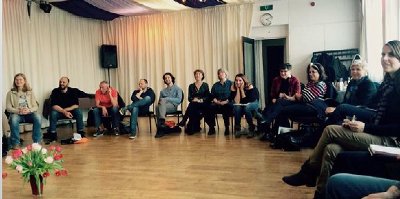
What does your team or organization reject, ignore, exclude, avoid, tolerate, irritate, or suppress? Take this issue and see it as a frog. Imagine you ARE that issue/frog: as a frog, you don’t want to be hurt, judged or even analyzed. You want to be known, accepted, and loved. Here’s the thing with frogs of any kind: love them or they won’t show up! And when they don’t show themselves – you can’t learn from them. You and the organization stay dumber than need be.
What would happen if you gently explored that frog? Imagine you are that frog – how does it feel, move, think, what is its place in the physical space? What is its posture, movement, pace? You can play with this, just like in systemic constellations (if you know the work of Bert Hellinger and others). If you embody this frog energy and take its place, you might get new insights. You might find the positive message that this frog may bring to the organizational system if it were allowed to show its face.
Frogs have implications for teams and organizations. What if we used the transformative power of love in the workplace as well? Magic could happen on any ordinary Monday.
And, what if leaders were learners? Many leaders today think they must be experts who need to have all the answers. That assumption leads to fear of failure and rigidity. What if leaders could explore and play with frogs? What if they were allowed to be “silly”? What if these kinds of exercises were considered “normal”? How much more creative, intelligent, relaxed and resilient would we become?
Max and Ellen explore this briefly. Max: “If you don’t like the organization, don’t work with them. They’ll feel it. It won’t work. Always love your clients. They may not know why they hire you. But they feel it must be you.”
Be weird and impactful
“You have more impact by being weird. Don’t Photoshop yourself into a glossy, but mainstream image. Be you. Every one of us is a solution to a problem that the universe is working on.”
That’s the point of our next assignment. We need to find our “mojo”: our personal style, what is so typical of us. We need to know our anti-style as well. If we can play with our styles, we can be more impactful.
Let’s watch a demo with Bob. Bob tells about something he’s working on that matters to him. We watch for the main style and the anti-style: shown as incongruences. Bob tells about his project and is making himself small: he’s not supposed to be center stage – he’s the good, well-adjusted, modest boy. The group finds his anti-style by watching him closely – he is also a trickster who likes to play tricks on people.
Now, he is to amplify the anti-style to learn more from this. The trickster laughs: don’t bother about others too much! Bob experiments with his anti-style and integrates it – to become more authentic, and impactful: the “real” Bob. It creates a more powerful presence that is clearly visible to everyone watching.
As for me, my prevalent style is extrovert, energetic, dynamic, and upbeat. I tend to entertain others and uplift them: “It will be okay”. My anti-style is frowning and frustrated – also seeing the half-empty glass, giving in instead of spreading hope. My anti-style says: “Phew, I’m tired. When will the others do more? I’m all alone pushing a whole planet. I’m the heroine – I’ve got 24 hours to save the world. Sigh. Who is going to cheer ME up?”
During the exercise, when I embody this tired and frustrated anti-style I get the insight that it is okay to voice these downsides. It’s okay to let the frustration show. It’s best to be completely open – not only give a voice to the upside, but allow the downside as well. Allow fears and frustration or tiredness to blend with my positive, upbeat style when needed. You get to see a more complete me. A more authentic human, who has more impact.
This is an interesting exercise for leaders, coaches, and consultants. Being aware of your style and anti-style can make a huge difference.
Walk through walls
Last but not least, let’s use the magic of the mystic to overcome walls, closed doors, and other obstacles.
Ellen and Max show a great demo of a real case. Once upon a time there was a renowned university – and an applicant who needed a freelance job and who had a great idea for a new student course.
The applicant submitted this idea, but the University turned the offer down, as they routinely do. The university is at the top of their league. “Who are you, unknown and unworthy applicant?”
Closed door. The applicant can knock harder: send a better proposal or another email, or try to network and find someone who knows someone inside who can help open the door. Or, you can do this exercise.
It’s the way of the mystic: you “shapeshift” through the wall and become the university. What does the university see, feel, hear, think, and want?
Inside, take a look at the university’s lock. How can you open it? Also check: do you still want to open it? Are you meant to be inside? Feel your WHY. Do you want to be inside because you need to be there, and is it aligned with your purpose? Or is it just your survival fears because you need to pay the bills? Do you LOVE being inside?
During this exercise, the applicant discovers that the university is strained and overworked. They don’t have time to read proposals or consider alternative courses. The lock is “lack of time”. What is the key? The applicant wants to be there to serve – he has a strong Why. Exploring the university with kindness brings understanding, and he writes a heartfelt thank-you email: “Thanks for all you do for students. I understand you are inundated. Thanks for your willingness to reconsider my idea next year. I know what piles of emails you must go through, and I appreciate your efforts.”
That email would not have been possible without this loving exploration. It created an opening. It is a true story: the course idea was accepted and realized.
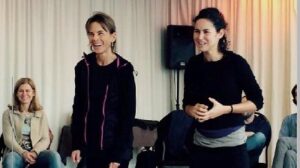
In this demo, the wall was a real, outside obstacle. But a wall can be anything that stops you – including your own fears.
So, let’s check: what do you want and what are you afraid of? That is your wall. Make space for the fear. What would be good about the fear? Are there closed doors that you already encountered or that you anticipate? Shapeshift and understand the other side. Do you still want to be inside that door? If you want to be inside, what is the key to unlocking the door?
Don’t push – chill out
Here’s my example. I come up with a ton of fears: I want to help make the world a better place (starting with the workplace) but I am afraid to be not good enough (an all time classic!). I fear to struggle alone. I fear it’s too heavy for me to spread this message of love and positive change – because I get tired.
Is there anything good about that? The fears are trying to protect me from wrecking my health.
I also experience obstacles outside of me: it’s hard to get attention for this positive blog because people are overwhelmed with information and too busy. In my role as a consultant, it’s tough to find organizations willing to do all the work it takes to create a culture of kindness (instead of going for a quick and glossy band-aid).
Do I still want to fulfill my mission of spreading positive change? You bet I do! What’s the key to unlock and widen my reach and inspire more people? Patience, persistence, and playfulness. Take it lightly. Don’t push. I will go on about positivity – and I will attract more people like you, my readers, over time.
I get tired when I push impatiently. I can do one day at a time. I can be lighthearted because we will get there eventually.
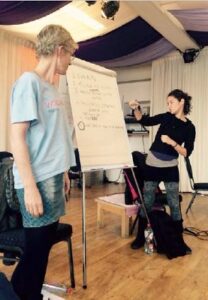 My above exercise may not make much sense when you read it. But if you do this exercise yourself, you will find personal insights to break through your walls – with the tender focus of interested kindness: “Hey, wall, you are so kind to obstruct me. You challenge me to learn something new. I look forward to finding the key to your lock. Thanks for making me wiser!”
My above exercise may not make much sense when you read it. But if you do this exercise yourself, you will find personal insights to break through your walls – with the tender focus of interested kindness: “Hey, wall, you are so kind to obstruct me. You challenge me to learn something new. I look forward to finding the key to your lock. Thanks for making me wiser!”
If you made it this far, you might glimpse the implications of kissing frogs. What if we would approach our challenges, problems, and obstacles as mystics? The world would become our playing field, daily frustrations could form an intriguing puzzle, our competitors could be bringers of wisdom, and we would appreciate them.
What if we were no longer afraid of the word love? It would make our work, the workplace, and the world so much lighter and brighter.
Journaling Questions
- What is your automated response to challenges and obstacles?
- What is your frog and why did it pick you? How can you love it? What’s its positive message?
- What’s your natural style? And your anti-style? When and how and with whom do you have the most positive impact?
- Explore “the other side”: what is it like (for them)? How can you appreciate this side? How can you love this obstacle and transform it?
If you have experience with Process Work, or psychodrama, bodywork, or NLP, or if you simply feel comfortable with the exercises as described: do and experience them! You’d be surprised at what you may uncover – insights that you cannot reach with your mind while thinking.
More information: https://www.deepdemocracyinstitute.org/
Upcoming events: https://www.deepdemocracyinstitute.org/calendar-listview.html

Workshop photos by Barbara K. Lusche
Marcella Bremer is an author and culture & change consultant. She co-founded this blog and ocai-online.com.
